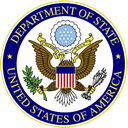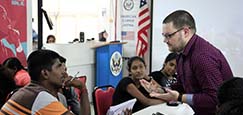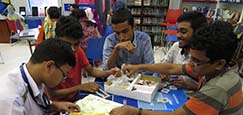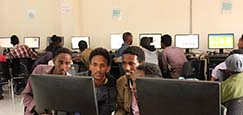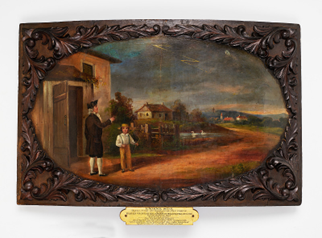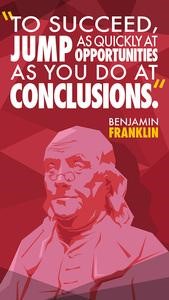BENJAMIN FRANKLIN
PROGRAM TOOLKIT FOR AMERICAN SPACES
This toolkit is designed for programming at American Spaces to introduce Founding Father and inventor Benjamin Franklin and highlight his essential contributions to science and government in the United States.
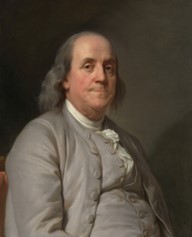
Key Definitions
Abolitionist – A person who supports ending slavery.
Almanac – An annual publication with weather forecasts, calendars, and advice.
Autobiography – A self-written account of one’s life.
Diplomat – A person who officially represents their country abroad.
Electricity – A form of energy resulting from the movement of charged particles.
Enlightenment – A movement during the 1600s and 1700s that celebrated reason as a way to achieve knowledge, freedom, and happiness.
Experiment – A scientific procedure to test a hypothesis.
Founding Father – A leader who played a significant role in establishing the United States.
Kite experiment – Franklin’s famous 1752 experiment using a kite, key, and storm to prove that lightning is a form of electricity.
Patent – Legal protection for inventions.
Printing press – A device for mass-producing printed materials.
Public library – An institution providing free access to books and information.
MORE RESOURCES
Videos and Digital Media
Benjamin Franklin: A Film by Ken Burns | Kanopy (3 hours, 47 minutes) – This two-part documentary from PBS was released in 2022 and explores Benjamin Franklin’s scientific and political contributions.
Benjamin Franklin: Writer, Inventor, and Founding Father (3 minutes) – This short video from PBS focuses on Franklin’s innovations and their connections to the Enlightenment. Available in English and Spanish.
Ben Franklin, Inventor and Founding Father | Biography (3 minutes) – This short documentary highlights Benjamin Franklin’s remarkable life, covering his youth, the creation of “Poor Richard’s Almanack,” his influential work as a printer and inventor, his groundbreaking experiments with electricity, his key roles in American politics—including signing the Declaration of Independence and drafting the Constitution—and his later advocacy against slavery.
Benjamin Franklin: Author of the Declaration of Independence | Biography (47 minutes) – This full-length documentary explores the remarkable life of Benjamin Franklin, highlighting his achievements as a scientist, inventor, writer, philosopher, statesman, and diplomat; it traces his journey from humble beginnings to international fame, examines his key inventions and civic contributions, and offers insights into his complex character and lasting impact on American history.
Articles
- Benjamin Franklin | The White House
- Benjamin Franklin | National Museum of American Diplomacy
- Benjamin Franklin and Science | National Park Service
- Biography: Benjamin Franklin | PBS
- 10 Facts: Benjamin Franklin | American Battlefield Trust
- Benjamin Franklin and the Kite Experiment | The Franklin Institute
Honoring Benjamin Franklin
- $100 Bill: Franklin’s image is featured on the front of the $100 bill.
- Franklin Half-Dollar: His image was engraved on the Franklin half-dollar, in circulation from 1948 to 1963.
- The Franklin Institute – A science museum and a center of science education and research in Philadelphia, Pennsylvania. Named after Benjamin Franklin and home of the Franklin National Memorial.
- U.S. Postage Stamps: Franklin’s image has appeared on U.S. postage stamps, including the first stamps issued in 1847.
- U.S. Savings Bonds: He has also been depicted on U.S. Savings Bonds.
Poster of Ben Franklin
This graphic of Benjamin Franklin can be used by American Spaces for wall coverings, posters, or digital marketing. It is part of the American Spaces graphics collection available in Google Workspace. To request access, please click the image and allow 48 hours for a response.
INTRODUCTION
The United States is a leader in innovation and civic development. Founding Father Benjamin Franklin (1706–1790) was a pioneering inventor and a principal architect of American independence. His inventions demonstrated his commitment to practical solutions that improved everyday life. As a statesman, Franklin helped draft the Declaration of Independence, negotiated crucial alliances during the Revolutionary War, and shaped the U.S. Constitution. This toolkit provides videos, articles, and lesson plans for American Spaces audiences to explore Franklin’s legacy as a renowned inventor and a foundational figure in the creation of the United States.
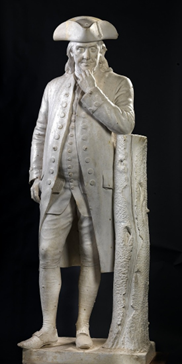
BACKGROUND INFORMATION
Benjamin Franklin was a key figure in early American history, celebrated as a Founding Father, scientist, inventor, and diplomat. Born in Boston in 1706, he had limited formal education. He rose from humble beginnings to become a successful printer and publisher in Philadelphia. His popular publication, Poor Richard’s Almanack, offered practical advice and witty observations, helping him gain both wealth and influence.
Franklin’s scientific achievements include his famous kite experiment, which proved lightning is electrical, and inventions like the lightning rod, bifocals, and Franklin stove. As a statesman, he helped draft the Declaration of Independence, secured French support during the Revolutionary War, and contributed to the U.S. Constitution. His inventions and civic initiatives reflected his belief that innovation and public service were essential to building a strong, unified nation. Franklin’s legacy endures as a model of how inventive thinking and nation-building can work hand in hand.
Scientific Achievements and Inventions
Franklin’s fascination with science led to groundbreaking research in electricity. He introduced important electrical words like “battery,” “positive charge,” and “negative charge.” Franklin developed new methods for generating, storing, and using electricity. His invention and advocacy of the lightning rod dramatically reduced the risk of fires caused by lightning strikes worldwide. Franklin’s most famous electrical experiment took place in June 1752, when he instructed his son William to fly a silk kite equipped with a metal wire and a key during a thunderstorm. The kite collected an electric charge from the storm clouds, which Franklin could capture and compare to other sources of electricity he had studied. This experiment not only advanced scientific understanding but also led to practical applications.
Notable Inventions
Lightning Rod: Franklin’s lightning rod protected buildings and ships from fire by safely channeling electricity to the ground. The metal rod was mounted on roofs and connected to the ground to protect structures from lightning strike.
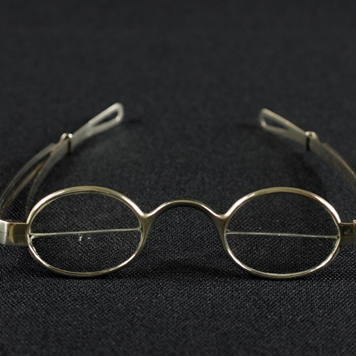
Bifocal glasses: Tired of switching between two pairs of glasses, Franklin invented bifocals, allowing users to see both near and far.
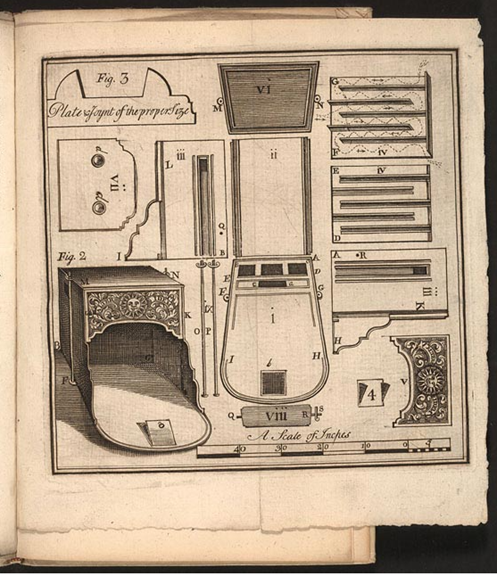
Franklin stove: Designed to provide more heat with less wood and smoke, the Franklin stove improved home heating efficiency.
Other Innovations: Franklin also invented the glass armonica, swim fins, and a flexible urinary catheter, seeking practical solutions to specific problems.
LESSON PLANS
Benjamin Franklin’s Many “Hats” – This lesson plan from EDSITEment includes readings and questions about Benjamin Franklin’s life, highlighting the many roles he played—as inventor, scientist, community leader, and Founding Father. Students will learn about the character traits and experiences that shaped his achievements and contributions to American society.
Benjamin Franklin & Engineering for Good: STEM and Media-Making Extensions – This video resource and lesson plan from PBS LearningMedia features engaging clips, discussion questions, and extension activities that help students explore Benjamin Franklin’s inventive spirit and his impact as an engineer and problem-solver.
Bell Ringer: America’s First Diplomat – This lesson plan from C-SPAN Classroom includes a video and discussion questions about Benjamin Franklin’s role as America’s first diplomat. Students will learn about Franklin’s work in France during the Revolutionary War and the intrigue that surrounded his diplomatic efforts.
Lesson Plan: The Legacy of Benjamin Franklin – This lesson plan from C-SPAN Classroom includes video clips and questions about Benjamin Franklin’s life and legacy, highlighting his childhood, family, and accomplishments. It has discussion activities and graphic organizers to analyze how Franklin’s actions shape American society today.
DISCUSSION QUESTIONS
- How did Benjamin Franklin’s inventions, such as the lightning rod and bifocals, change daily life in colonial America?
- How did Franklin’s founding of institutions like the Library Company of Philadelphia and the University of Pennsylvania reflect his commitment to public service?
- What challenges did Franklin face when introducing new ideas like the lightning rod? How did he overcome skepticism from other people?
- How did Franklin’s scientific research and inventions influence his reputation in America and abroad?
- What is the impact of Franklin’s inventions and civic initiatives on modern society?
- How did Franklin’s work as a printer and publisher spread his scientific and political ideas throughout the colonies?
- How did Franklin’s approach to innovation—sharing his inventions freely—reflect his vision for a better society?
Overdrive (Libby) Books
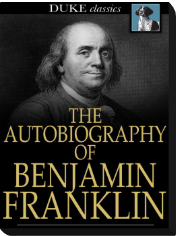
The Autobiography of Benjamin Franklin | OverDrive (Libby) – Benjamin Franklin offers a firsthand account of his early life, career, experiments, and philosophy, providing readers with an engaging and insightful look at his journey from humble beginnings to becoming a key figure in American history. Available as an ebook and audiobook.

The Way to Wealth | OverDrive (Libby) – This short, accessible collection presents Benjamin Franklin’s most famous advice and proverbs from Poor Richard’s Almanac, offering timeless lessons on hard work, frugality, and success in a format suitable for all readers.
The views expressed in these links and resources do not necessarily reflect those of the U.S. government.
Updated June 2025

